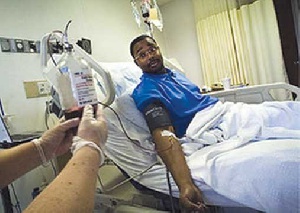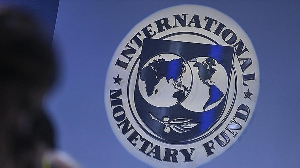When four-year-old Mildred Adubea Frempong collapsed, her parents became alarmed.
Not knowing what might have happened to their third child who was healthy a few minutes before the blackout, Mr and Mrs Ansong Frempong rushed Mildred to the Tetteh Quarshie Hospital.
It was upon reaching the hospital that their worst fears were confirmed. Two days after her admission to the hospital, Mildred was diagnosed to be sickle cell positive which has led her to have a stroke.
The family was quickly referred to the Korle-Bu Teaching Hospital for specialist treatment and that is where Mildred has been receiving care for the past three years.
Although Mr and Mrs Ansong Frempong, both teachers, carried a sickle cell trait and knew about the 25 percent possibility of having a child with the diseases, their discovery that Mildred had sickle cell disease came as a shock to them.
“When our first and second children were born, they were checked for the disease and they were negative but the test was not conducted for the third when she was born because we did not think she could get it,” he said.
“Surprisingly, she was found to be the healthiest among the three, from childhood unlike the two other siblings who frequent the hospital during their childhood, Mildred was always healthy. The only time we would go to the hospital was for normal weight and routine checks but to fall sick, no. Mildred was very healthy and she grew very fast,” Mr Ansong Frempong added.
Sickle Cell disease
Sickle cell disease is a genetic blood disease due to inheritance of mutant haemoglobin genes from both, generally healthy, parents.
According to the World Health Organisation, sickle cell disease is one of the two haemoglobin disorders that affect how oxygen is carried in the blood.
The misshapen cells lack plasticity and can block small blood vessels, impairing blood flow. This condition leads to shortened red blood cell survival, and subsequent anaemia, often called sickle-cell anaemia.
Poor blood oxygen levels and blood vessel blockages in people with sickle-cell disease can lead to chronic acute pain syndromes, severe bacterial infections and necrosis (tissue death).
It indicates that the haemoglobin disorder is inherited from parents in much the same way as blood type, hair colour and texture, eye colour and other physical traits, adding that the sickle-cell disease can occur only when both parents are carriers of trait genes for the particular condition.
“A child who inherits two of the same trait genes – one from each parent – will be born with the disease.
However, a child of two carriers has only a 25 percent chance of receiving two trait genes and developing the disease, and a 50 percent chance of being a carrier. Most carriers lead completely normal, healthy lives,” it stated.
Approximately five percent of the world’s population carries trait genes for haemoglobin disorders, mainly, sickle-cell disease and thalassaemia with over 300 000 babies with severe haemoglobin disorders born each year.
Explaining the magnitude of the health crisis, Dr Sefakor Enam Bankas, who is a person living with sickle cell disease and sickle cell disease advocate, stated that two percent of all children born in the country every year have sickle cell disease “that translates into 15,000 children a year with the disease”. It is one of those easily preventable, non-communicable and non curable diseases.
Getting treatment
Dr Bankas said due to extensive research and advancement in medicine, there is a cure for sickle cell disease; unfortunately, the cure is not generally accessible, affordable or available.
Thus, much as in theory sickle cell disease can be cured, in reality, only a few patients with the most severe disease ever get access to it.
The mainstay of management, she said, is symptomatic relief and complication prevention.
“This involves the use of drugs such as folic acid and hydroxyurea, frequent blood transfusions, effective pain management and continuous monitoring through laboratory investigations and imaging studies to prevent the occurrence or progression of complications such as sickle cell retinopathy, nephropathy and avascular necrosis,” she said.
Mr Ansong Frempong said they were given two options for Mildred’s treatment by the team of doctors taking care of her at Korle-Bu.
They were given blood transfusion and hydroxyurea to boost blood production through bone marrow because her blood level was too low, “so we started with blood transfusion and then hydroxyurea which her system was adjusting to the medication.”
“At the time we spent close to GH¢27,000 after 19 days, she was better but she lost her memory and we had to start all over again, going through physiotherapy and clinical psychologist,” he said.
In a month’s time, Mildred was back on her feet walking though limping partially on right leg with a little defect and loss of control of her fingers.
The parents kept providing her medication and making sure she is managed appropriately and soon she went back to her old self, excelling in her academics.
“We were told her situation was as a result of the sickle cell condition. Her water intake was too low so she was put on water therapy,” he said.
Challenges
Just when the Frempong family thought they have overcome the sickle cell threat and are coping with the management of the disease, the unexpected happened.
Mildred had an intensive attack and her situation deteriorated further, doctors said her body was no more accepting the hydroxyurea because even though they kept increasing the dosage, her blood level was rather declining.
“One afternoon in October 2015, Mildred was washing and she realised her hands could not hold her dress, she told me about the change in her condition and a few minutes later she collapsed,” Mr Frempong said.
“We sent her to Korle-Bu and it took almost four to six hours for them to stabilise her condition. She spent close to two weeks at Korle-Bu and from that day till date there has not been any improvement.”
Mildred again lost her memory, could not remember anything and her family had to start teaching her all over again.
“Now, we have to teach her the alphabets again, she virtually eats and does few things with her left hand as her right hand is weak as we continue with her medication,” he said.
Effect
Mildred’s situation has had dire consequences on herself and family.
She has been out of school for six months because of her medications and management which should be under strict supervision following severe attacks of stroke and nervous disorders.
He said her daughter sometimes weep because she cannot do things she used to do so because of that it has affected her other siblings
Mr Ansong Frempong said the family’s finances have changed drastically. “I have lost all my saving and taken loans from banks to support her treatment. Our economy now revolves around her,” said.
Her father spends close to GH¢1,700 a month on the average, but from October 2015 to date, the family spends close to GH¢4,000 a month on her treatment.
He said blood transfusion has also given the family some challenges because of the transfusion she had iron overload and the medicine that was needed for the iron to be reduced cost over GH¢6,800.
“Psychologically, the family has been tormented, now we are not happy, the once academic brilliant Mildred we knew when I look at her now I get sad, her doctor has been telling me when all is well and she will come back so that is my hope,” he said.
The family also spends almost all of its time with her. “We cannot go out as a family because anytime at all Mildred can collapse, between October last year and July this years she has collapsed five times and each of them was deadly.”
We are not only trusting in the healing power of our Saviour to heal her. The National Health Insurance Scheme (NHIS) was only covered the OPD charges all the charges we pay because they are not covered by NHIS,” they added.
Appeal
The team of doctors taking care of Mildred has suggested a bone marrow transplant as tests showed that she has a peculiar defect with her bone marrow which is causing it not to produce enough blood.
Doctors have, therefore, recommended that she goes through the medical procedure outside the country expected to cost $97,700 (GH¢390,800).
A letter from the clinic signed by Dr Sudha Rao, Senior Resident at the Paediatric Sickle Cell Clinic, said the cost of the procedure alone, excluding travel expenses, accommodation cost and other medical care for the donor in India is approximately USD 45,000 if she gets a 100 percent HLA matched donor.
“The expenses are higher than the above mentioned amount if 100 % matched HLA donor is not available,” the letter indicated.
“The amount involved is beyond what we can afford but if we get the money today, we are ready for the transplant because we have a donor,” Mr Frempong said.
“We were advised that if it is possible we should have this done by the end of June, so now we are living under the grace of God and wishing that God should grant us an opportunity for a miracle or help us raise the money.”
As Mildred waits for the money to be raised for her treatment, her father Mr Frempong is calling on government to make it more affordable for families with persons living with sickle cell through the provision of more specialised hospitals and funding to reduce the cost families incur when caring for persons with sickle cell disease.
Opinions of Saturday, 30 July 2016
Columnist: Jamila Akweley Okertchiri















